
A beautiful green lawn should not be missing in any garden, whether as an ornamental lawn or a play area for romping children. Not only the type of grass is important, but also the amount sown. We answer the question of whether you can sow too much lawn seed.
In a nutshell
- too much grass seed is harmful
- Seedlings will develop poorly otherwise
- eventually many die
- sow 30 to 40 g per square meter depending on the lawn mixture
- Always calculate the ideal amount correctly
Large amounts harm
Some hobby gardeners are guided by the motto "a lot helps a lot" when laying out a lawn, in order to achieve a beautiful, green and dense lawn more quickly. However, this guiding principle should not be considered when sowing lawn seeds. A sustainable and very robust lawn surface can only develop if the seed is dosed correctly. On the other hand, if you sow too much lawn seed, this can have serious consequences, because a grass plant measuring 8 x 8 cm grows from one seed:
- young seedlings compete for water, nutrients and light
- Plant roots get little air
- Interference between plants in development and growth
- increased death of seedlings
- Formation of increased lawn thatch
- resulting in poorer ventilation of the soil and lawn
- Lawns need to be scarified frequently
- sometimes changing the composition of the lawn mixture
- as some varieties are more competitive than others
- This also changes the properties of the mixture (load capacity, etc.)

In addition, too little sowing of the appropriate seed has a decisive effect on the creation of a lawn, for example
- bald patches in the lawn
- larger spaces between individual grass plants
- rapid spread of weeds such as trefoil, dandelion or daisy
For the reasons mentioned above, it is therefore important to know the exact amount of lawn seed required.
Notice: Most lawn mixes consist primarily of two different types of grass, bluegrass (Poa pratensis) and perennial ryegrass (Lolium perenne). The mixing ratio is different depending on the use.
Calculate ideal amount
The individual manufacturers give instructions on how to use the amount on their packaging so that you don't sow too much lawn seed. However, it must be said that not every lawn mixture is the same. As a rule, 30 to 40 g per square meter are given, depending on the type of lawn:
- Sports and play turf average 30 g per square meter
- Decorative lawn 25 g per square meter
- to repair gaps 5 g per square meter
In addition, the information provided by the manufacturer can also vary, especially with low-quality seed, i.e. cheaper varieties, often larger quantities are required because the germination rate is low. In general, the following formula should be used when calculating the ideal amount of seed:
Sowing area in square meters x seed quantity in g per square meter (to be found on the packaging) = required sowing quantity
Here's an example: 100 square meters of area x 30 g of seeds per square meter = 3000 g
You should not use more seed for this area either.

Notice: Not only the ideal amount of seed is important for success, but also the right time of sowing. The soil temperature should always be above 10 °C. The months of April / May and August / September are ideal for this.
right technique
Even with the wrong sowing technique, you sometimes cannot spread the lawn seed across the board and will sow too little or too much in isolated places. Therefore, you should consider the following when sowing:
- Divide the area into three or four pieces
- Application with spreader
- set this correctly
- Take it piece by piece
- Finally, drive across the surface again in a transverse direction
- Lightly distribute smaller heaps of seeds with a rake
- walk backwards when applying by hand
- vigorously distribute seeds evenly
Note: Only work in the lawn seeds lightly with the rake, do not cover them with soil (light germinates). Then press down well with a roller, alternatively step down with a board.
frequently asked Questions
How should the soil be prepared for sowing a lawn?The ground must be freed from stones, branches or root remains. This requires deep loosening, either with a motor hoe or with a spade. The ground is then leveled with a rake and consolidated with a lawn roller. Alternatively, the floor can also be left for two weeks to solidify. Before sowing, it is then roughened up a bit with a rake.
What care does the lawn seed need after sowing?As a rule, the lawn seed germinates after eight to 14 days. To do this, however, it needs sufficient moisture. Regular watering is now necessary. The area should be watered primarily in the morning or evening hours for about 10 to 15 minutes. It is important to ensure that the water jet is not too hard, otherwise the seeds will be washed out. The best way would be to use lawn sprinklers to evenly sprinkle the area.
When should the newly seeded lawn be mowed?The lawn should be mowed for the first time when it is eight to ten centimeters high. Then the young grass plants have sufficiently rooted themselves in the ground. The lawn mower should be adjusted to a height of between five and six centimetres. After that, mowing weekly or every fourteen days makes sense, but not at temperatures above 30 °C, otherwise the young blades of grass will burn. After eight weeks at the latest, the lawn is fully resilient.